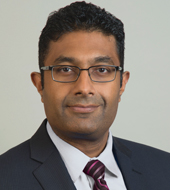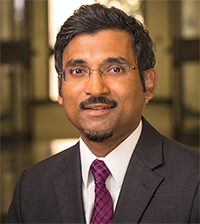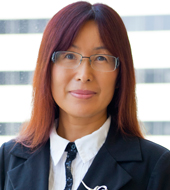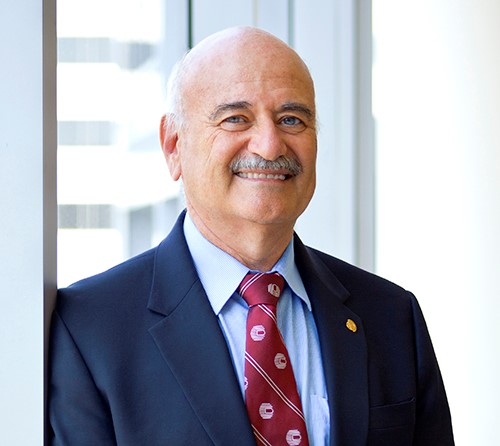Background
Age-Related Macular Degeneration
Research
Stephen J. Ryan
AMD Research at Doheny
The retina of the eye contains millions of highly specialized cells. Some of the cells capture images (in the form of light) from the visual field. Others carry the information to the brain where it is translated into what we see. The cells are supported by a structured “floor” and nourished by a unique system of blood vessels that also carry away cellular waste products. The varieties of retinal cells are confined, for the most part, to distinct retinal layers and are affected differently by retinal disorders. Some disorders affect the light capturing cells. Others cause the brain-connecting cells to fail. Some do so by altering the floor or vasculature and others by disrupting the internal workings of the cells. Age-related macular degeneration (AMD) is one of the retinal disorders being studied by scientists at Doheny Eye Institute.
Researchers are finding new ways to prevent, treat, and cure retinal disorders. These range from nutritional therapies to stem cell therapies. The nutritional therapies, for some forms of AMD, help patients who are at a mid-range stage of the disease. The stem cell therapies are designed to repair the retinal floor, called the retinal pigment epithelium, which malfunctions in many retinal degenerative disorders.
A specialized program at Doheny Eye Institute called the Doheny Image Reading Center (DIRC) is critically important to the worldwide vision research community. DIRC receives photographic images of the retinas of patients with retinal disorders at various stages; the DIRC scientists analyze and report on the images; the reports help scientists and medical doctors evaluate the effects of standard and experimental therapies on the progression of patients’ retinal disease.
Srinivas Sadda, MD

Srinivas R. Sadda, MD
Executive Committee Chair, RIMR
Director of the AI Laboratory at Doheny Eye Institute
Professor, David Geffen School of Medicine at UCLA
Dr. Sadda received his medical degree from The Johns Hopkins University in Baltimore, Maryland. After an internship at the William Beaumont Hospital in Royal Oak, Michigan, he returned to Johns Hopkins University and the Wilmer Eye Institute in Baltimore for an ophthalmology residency as well as neuro-ophthalmology and medical retina fellowships.
Dr Sadda’s major research interests include advanced retinal imaging technologies, image analysis algorithm development, retinal stem cells, translational research, clinical trial endpoint and biomarker development. Clinical disease interests include AMD, diabetic retinopathy, and retinal degenerations.
In pursuit of these interests, Dr. Sadda is or has been the Principal Investigator on more than 30 trials, including phase III studies of ranibizumab, preservative-free triamcinolone acetonide, and a dexamethasone posterior segment drug delivery system. He has more than 300 publications in peer-reviewed journals and over 300 published abstracts. He authored the first edition of the textbook Emerging Technologies in Retinal Disease, as well as 13 book chapters. As an invited lecturer, he has given more than 250 presentations around the country and the world. Dr. Sadda also serves as an editorial board member of Ophthalmic Surgery, Lasers & Imaging, Retina, and Ophthalmology. He is an editor of the 5th edition of the Ryan’s Retina textbook and also serves as the editor for the electronic edition of this text. In addition, he serves as an ad hoc scientific referee for Investigative Ophthalmology and Visual Science, Archives of Ophthalmology, American Journal of Ophthalmology, Experimental Eye Research, and the Center for Scientific Review at the National Institutes of Health. Among Dr. Sadda’s awards and honors are a Research to Prevent Blindness Physician-Scientist Award, a Senior Honor Award from the American Society of Retina Specialists, Silver Fellow designation from ARVO, an Achievement Award and a Secretariat Award from the American Academy of Ophthalmology, John H. Zumberge Research and Innovation Award, and the Macula Society Young Investigator Award. He has been named to the Best Doctors of America list for several consecutive years.
Deborah Ferrington, PhD
Deborah Ferrington, MD
Stephen J. Ryan-Arnold and Mabel Beckman Foundation Endowed Presidential Chair and Chief Scientific Officer, Doheny Eye Institute
Executive Committee Member, RIMR
Professor, David Geffen School of Medicine at UCLA
Dr. Ferrington is internationally recognized for her ground-breaking research on age-related macular degeneration (AMD), which is the leading cause of blindness among those over 60 years of age in the developed world. In her role as CSO, Dr. Ferrington will focus on leading and expanding the Institute’s research initiatives.
Dr. Ferrington has more than 20 years of experience in academic research, most recently as Professor and Elaine and Robert Larson Endowed Vision Research Chair in the Department of Ophthalmology and Visual Neurosciences at the University of Minnesota, Twin Cities. She completed her undergraduate degree in Biological Science and Scientific Illustration and a Master of Education program from the University of Pittsburgh. Dr. Ferrington went on to receive her PhD in Biochemistry from the University of Kansas, where she also completed a postdoctoral fellowship.
Dr. Ferrington currently serves as a Permanent Member of the National Institutes of Health (NIH) “ Biology and Development of the Eye” Study Section. She has been the recipient of various NIH grants funded by the National Eye Institute (NEI) and National Institute of Aging (NIA) and has been funded by Foundation Fighting Blindness and the BrightFocus Foundation. She has published more than 90 peer-reviewed papers and has co-authored several chapters in seminal scientific books.
Steven Barnes, PhD

Steven Barnes, PhD
Doheny Scientist
Professor, David Geffen School of Medicine at UCLA
Dr. Barnes received his PhD from University of California, Berkeley in Berkeley, California. He completed his postdoctoral fellowship in Physiology and Biophysics at the University of Washington in Seattle, Washington. He was previously at the University of Calgary in Alberta, and at Dalhousie University in Halifax, Nova Scotia. He has served as a research biologist for the Veterans Administration Greater Los Angeles Health System and worked part time for the Department of Neurobiology at UCLA’s David Geffen School of Medicine.
Dr. Barnes’ research interests include the neurobiology and physiology of the retina, ion channel biophysics, synaptic mechanisms, calcium signaling, macular degeneration, glaucoma, and retinal dysfunctions in traumatic brain injury.
Dr. Barnes’ work investigates retinal dysfunction and disease, specifically in regard to the roles of voltage and ligand-gated ion channels in the visual function of the retina. His research programs have aided the identification of therapeutic strategies that could reduce, eliminate or slow damage to retinal neurons in diseases such as glaucoma. He was recently granted a Glaucoma Research Foundation Shaffer Award to initiate studies of novel aspects of ganglion cell dysfunction during bioenergetics stress.
Kaustabh Ghosh, PhD
Kaustabh Ghosh, PhD
Doheny Scientist
Associate Professor, David Geffen School of Medicine at UCLA
Dr. Kaustabh Ghosh received his PhD in Biomedical Engineering from Stony Brook University, New York, and obtained his undergraduate degree in Chemical Engineering from National Institute of Technology, Warangal, India. Dr. Ghosh was a postdoctoral fellow in the laboratory of Donald Ingber, MD, PhD, part of the Vascular Biology Program at Boston Children’s Hospital and Harvard Medical School.
Dr. Ghosh joined Doheny and UCLA Stein Eye Institutes in 2019 as Associate Professor in basic science at the UCLA David Geffen School of Medicine. Dr. Ghosh is distinguished as an interdisciplinary researcher with expertise in the fields of vascular inflammation, mechanobiology, bioengineering, and nanomedicine.
Prior to Doheny, Dr. Ghosh was Associate Professor of Bioengineering at University of California, Riverside (UCR) as well as Participating Faculty in the Division of Biomedical Sciences, Stem Cell Center and the Program in Cell, Molecular and Developmental Biology. The Ghosh Research Group at UCR focused on leveraging the principles of mechanobiology to examine and treat inflammation‐mediated vascular degeneration associated with diabetic retinopathy and age‐related macular degeneration, the leading causes of vision loss in the diabetic and aging population. In 2016, these studies were supported by two R01 grants from the National Eye Institute (NEI), and a macular degeneration grant from the BrightFocus Foundation. Dr. Ghosh has received numerous awards during his research career, including the Hellman Fellowship and the NIH Postdoctoral Training Grant, and has published 24 peer-reviewed papers in highly-regarded journals that include PNAS, The FASEB Journal, Science, and Nano Letters, among others.
Zhihong (Jewel) Hu, PhD
Zhihong (Jewel) Hu, PhD
Doheny Scientist
Dr. Hu received her Ph.D. in Electrical and Computer Engineering from the University of Iowa. She is the supervisor and lead software developer in the Doheny Image Analysis Laboratory (DIAL) at the Doheny Eye Institute. Dr. Hu’s overall research interests are in the fields of medical image processing, computer vision, machine learning, and video surveillance. Her latest research focuses on ophthalmic image processing and analysis, with the special attention in graph-based image segmentation, supervised pixel classification, deep learning, multi-object, multi-modality image segmentation, and uni-modal and multi-modal image registration.
When Dr. Hu worked in the University of Iowa, she specialized in the automated detection and analysis of the glaucomatous 3D eye structures involving the neural canal opening, optic cup, rim, and blood vessels, using 2D and 3D spectral domain optical coherence tomography (OCT) images. After she joined Doheny, she turned her attention to age-related macular degeneration (AMD).
Her research specializes in the automated detection and analysis of eye structures and lesions involving AMD using 2D and 3D OCT images. Dr. Hu has developed various automated algorithms to identify AMD structures and lesions to facilitate the understanding of the mechanism of AMD. For instance, Dr. Hu developed a graph-based algorithm to identify 11 retinal layers in OCT images. The automated multiple layer segmentation facilitates the analysis of the retinal layer thickness and reflectivity changes, which are believed to be the indicators/predictors of various eye diseases (e.g. AMD) and their progression. Recently, Dr. Hu developed a level-set-based algorithm and a pixel-wise-classification-based algorithm for the detection and quantification analysis of geographic atrophy (GA), the late stage of AMD. The preliminary GA segmentation and analysis results are promising and have resulted in the award of a research grant and an ARVO travel grant. Dr. Hu is also interested in the translation of her development to real-world applications and is pursuing the licensing of her development with OCT device companies.
An additional research interest of Dr. Hu’s is the development of manual graphical user interface (GUI) tools to facilitate retinal research. So far, the GUI tools can provide image data format conversion, visualization, registration, manual delineation (and manual correction of automated segmentation results), and quantitative analysis of retinal layer thickness, intensity and correlation with microperimetry sensitivity for 2D images and 3D macular OCT, which are important compensation for the automated algorithms.
Michael Ip, MD
Michael Ip, MD
Medical Director, Doheny Image Reading Center
Professor, David Geffen School of Medicine at UCLA
Dr. Ip received his medical degree from New York University in New York, New York. He completed his residency in ophthalmology at the University of Pittsburgh, School of Medicine in Pittsburgh, Pennsylvania and his fellowship in vitreoretinal surgery at the New England Eye Center, Tufts University in Boston, Massachusetts. He was on faculty at the University of Wisconsin, School of Medicine and Public Health in Madison, Wisconsin and was the co-director of the Fundus Photograph Reading Center. He currently serves as the Gavin S. Herbert Endowed Chair for Macular Degeneration and as Medical Director of the Doheny Image Reading Center at Doheny Eye Institute.
Dr. Ip’s major research interests include retinal disease diagnosis and classification and image reading centers. Clinical disease interests include diabetic retinopathy, age-related macular degeneration, retinal vein occlusion, and vitreoretinal surgery.
Dr. Ip has served as national principal investigator of the Standard Care vs. Corticosteroid for Retinal Vein Occlusion (SCORE) Study and as national co-principal investigator of the SCORE2 Study. This is a key study that tests first-line treatments for the build-up of fluid in the macula. He has authored more than 60 peer-reviewed articles and 20 book chapters. He serves as reviewer for Ophthalmic Surgery and Lasers, Investigative Ophthalmology and Visual Science, American Journal of Ophthalmology, Retina, and Ophthalmology. Dr. Ip has been recognized with several honors, including Senior Achievement Award and the Leadership Development Program Award from AAO.
Alfredo Sadun, MD, PhD
Alfredo Sadun, MD, PhD
Flora Thornton Endowed Chair of Vision Research
Chief of Ophthalmology, Doheny Eye Center UCLA
Vice Chair & Professor of Ophthalmology, David Geffen School of Medicine at UCLA
Dr. Sadun received his medical degree and Ph.D. from Albert Einstein College of Medicine in New York, New York. He completed his residency in Ophthalmology and fellowship in Neuro-Ophthalmology at Harvard Medical School. He was on faculty at Harvard Medical School before he joined Doheny Eye Institute. He currently serves as Flora L. Thorton Endowed Chair at Doheny Eye Institute and Vice Chair of Ophthalmology at University of California, Los Angeles.
Dr. Sadun’s major research interests include human visual neuroanatomy, retinal ganglion cell degeneration and regeneration, axon populations in the human optic nerve in development, aging, and disease; and mitochondrial impairments as a cause of optic neuropathy (LHON, DOA, toxic MON). Clinical disease interests include neuro-ophthalmology, optic nerve, optic neuropathies (PION, AION, TON), Leber’s hereditary optic neuropathy, toxic and nutritional optic neuropathies, and vision in Alzheimer’s Disease and other CNS disorders.
Dr. Sadun is recognized as an international authority in neuro-ophthalmology and disease of the optic nerve. He was the first to identify several optic nerve conditions related to AIDS and Alzheimer’s disease. He is known for his work in Cuba, where he determined the metabolic cause of sudden epidemic of blindness in 50,000 people. He has also led a large international team of investigators to field investigations in Brazil of the world’s largest pedigree of extended family members with Leber’s hereditary optic neuropathy (LHON), a blinding disease of the optic nerve. He has published 370 peer reviewed articles, 80 book chapters, co-authored or edited 5 books. Among his awards and honors are Pisart Award from Lighthouse International, Straatsma Prize from AAO and AUPO, Hoyt Award by AAO and NANOS and the Life Achievement Award from the AAO. He has been funded by the NIH for 25 years and holds 5 patents. He has been named as “Top Doctor” in his field by US News and World Report.
Yuhua Zhang, PhD
Yuhua Zhang, PhD
Doheny Scientist
Director of the Adaptive Optics Laboratory at Doheny Eye Institute
Associate Professor, David Geffen School of Medicine at UCLA
Dr. Zhang received his PhD in precision metrology and instruments engineering from Tianjin University in China. After moving to United States, he conducted research on adaptive optics retinal imaging at University of California, Berkeley. He then transferred to University of Alabama where he established an Adaptive Optics Ophthalmic Imaging Lab and developed a series of high resolution retinal imaging instruments including an adaptive optics scanning laser ophthalmoscope with optical coherence tomography (AO-SLO-OCT) and a high speed line scan confocal ophthalmoscope.
In Doheny Eye Institute, Dr. Zhang’s is developing new generation imaging technology for studying blinding eye diseases, including AMD, at the cellular level. The technology integrates state-of-the-art adaptive optics and advanced microscopic methods that will reveal the vision-producing cells and the structure of their supporting system in the living human eye.
Dr. Zhang has received prestigious R&D 100 Award for his development of a MEMS-based adaptive optics scanning laser ophthalmoscope. He is also a recipient of research grant from National Institute of Health to pursue his imaging studies of retinal lesions and photoreceptors in AMD.






